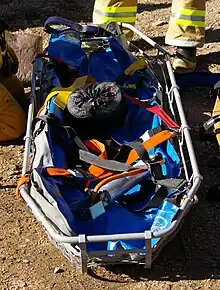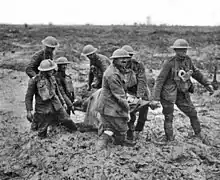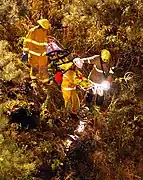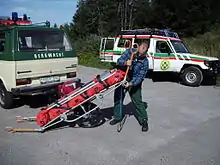Litter (rescue basket)
A litter is a stretcher designed to be used where there are physical obstacles that impair movement, including other hazards such as, in confined spaces, on slopes or uneven terrain, or in densely forested areas. Typically it is shaped to accommodate an adult in a face up position and it is used in search and rescue operations. The person is strapped into the basket, making safe evacuation possible. The person generally is further protected by a cervical collar and sometimes a long spine board, so as to immobilize the person and prevent further injury.


A litter essentially is a stretcher with sides (or just a raised edge) and a removable head and/or torso cover. They are most notably remembered from Korea and Vietnam images of United States Air Force Pararescue airmen or more recent Coast Guard video clips of helicopters rescuing injured people from isolated areas. Some will also recall the images from the TV shows Emergency! and M*A*S*H of fixed stretchers on either side of medical evacuation helicopters.
One widely used style of litter is the Stokes basket.
Uses
After the person is secured in the litter, the litter may be wheeled, carried by hand, mounted on an ATV, towed behind skis, snowmobile, or horse, lifted or lowered on high angle ropes, or hoisted by helicopter.
Litters are used to rescue victims in confined spaces, such as inside a ship or a cave network. Litters used in surface water rescue are equipped with floats. Litters used in mountain rescue usually are equipped with a cover or other material to protect the person from falling rocks. Litters used in search and rescue often can be disassembled for easier carrying. Some litters can be mounted on a wheel.
Stokes basket
.jpg.webp)
A Stokes basket, also called a Stokes stretcher or Stokes litter, is a metal wire or plastic litter widely used in search and rescue.[1] Its key feature is that it can be disassembled for transport in backpacks or by pack horse.
Originally designed by Charles F. Stokes,[2][3][4] these baskets have been notorious for spinning under the downdraft from the rotating helicopter blades. Design improvements have included using multiple attachment points, separate hold-down cables, and powered extension hoists to help save more lives. Recently the U.S. Navy has used the Stokes basket to transport patients through narrow corridors and doorways.
History
During the United States Civil War, horse-mounted litters were used to transport wounded soldiers from battlefields. Rear Admiral Charles Francis Stokes, retired Surgeon General of the Navy from 1910 to 1924, devised the Stokes stretcher.
Gallery
 Litter on wheels, made c. 1900
Litter on wheels, made c. 1900 Firefighters lowering a Stokes basket down a hill
Firefighters lowering a Stokes basket down a hill Patient transport sled managed by skiers
Patient transport sled managed by skiers A mountain rescue litter
A mountain rescue litter
See also
References
- "Dictionary definition of "Stokes basket"". A Way With Words (new home of) Double-Tongued Dictionary. Retrieved 2017-01-29.
- Mr. Grog. "RADM Charles F. Stokes, Surgeon General (1910–1914)". USSTranquility.blogspot. Retrieved 30 May 2013.
- "Charles F. Stokes, MD, FACS (1863–1931)". Highlight of the Month. American College of Surgeons, Chicago, IL. Retrieved 30 May 2013.
- "Stokes Stretcher Patent".
External links
- Emergency Response Training, Inc.
- Successful Patient Packaging By Michael Dunn
- Stokes litter images
- Charles Francis Stokes, ArlingtonCemetery.net, an unofficial website